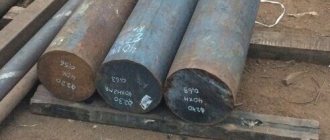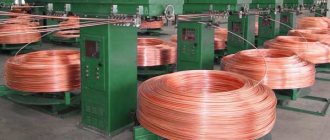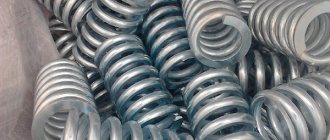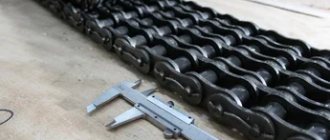The alloy, which is characterized by ease of use, ease of processing, good strength and hardness, as well as low cost, can confidently be called universal, applicable in any conditions. Steel 20 is not a specialized steel; on the contrary, its application possibilities are so wide that it has found a place in almost every industrial sector.
Detailed information on the supply of sheet steel and a price calculator can be found on our website.
Chemical composition
Steel grade 08PS is classified as structural carbon steel. The chemical composition is regulated by GOST 1050 - 88. It determines the mass fraction of the elements that make up the 08PS alloy, the data is given below:
- carbon from 0.05 to 0.11%;
- silicon from 0.05 to 0.17%;
- manganese from 0.35 to 0.65%;
- chromium no more than 0.10%.
Decoding
The name of steel 08PS is deciphered as follows:
- 08 amount of carbon;
- ps is an indicator of steel deoxidation, in this case it is semi-quiet.
There are three types of deoxidation, that is, removal of oxygen. Semi-quiet steel occupies an intermediate position between boiling and calm steel, while it contains all the positive properties of materials subjected to deoxidation by other means.
Properties
In general, this material shows good strength characteristics and hardness parameters. The positive features of 08PS include the fact that it is completely calm under the influence of various loads. If it does not exceed certain limits, then the product retains its original shape. But it should be noted that it may be deformed for some time with subsequent restoration. During the recovery period, the product will be in a tense state.
When choosing this material, it is necessary to remember that any material has a yield point, overcoming which the steel comes out of elastic deformation and begins to collapse.
Grade 8PS has good weldability. For welding operations, any existing technologies can be used. But we must take into account that after heat treatment, parts made from this alloy cannot be used for welded structures.
Analogs
When choosing 8PS steel for the manufacture of structures, the designer must remember that it can always be replaced with its closest analogue - grade 08. There are also foreign analogues:
When choosing imported materials as a substitute, you must remember that the delivery package must also include appropriate certificates confirming the quality of the material and its compliance with GOST.
ACCEPTANCE RULES
3.1. Rolled products are accepted in batches consisting of steel of one heat, one size and one heat treatment mode (when manufactured in a heat-treated state).
By agreement between the manufacturer and the consumer, batches are formed from steel of the same grade of several heats of the same size.
Each batch is accompanied by a quality document in accordance with GOST 7566.
When deoxidizing agents other than silicon are used for semi-quenched steel, a corresponding indication is made in the quality document.
For rentals accepted with characteristics established by the consumer in accordance with paragraphs. 2.2 and 2.3, the quality document indicates the test results for the ordered indicators.
3.2. The rolled products are subjected to acceptance tests.
3.3. To check the quality, the following are selected from a batch of rolled products:
- for chemical analysis - samples in accordance with GOST 7565. The manufacturer periodically controls residual copper, nickel, chromium, arsenic and nitrogen, at least once a quarter. When producing steel, taking into account the manganese equivalent, control of residual copper, nickel and chromium is carried out at each heat;
- to control surface quality and dimensions - all rods, strips and coils;
- to control the macrostructure by fracture or etching, to test for impact bending, to determine the depth of the decarbonized layer - two rods, strips or coils;
- to test hardness - 2% of rods, strips or coils, but not less than 3 pieces;
- for tensile testing - one rod, strip or coil for control in a normalized state, two rods, two strips or two coils for control in a cold-worked, annealed, high-tempered or tempered condition;
- to determine hardenability - one rod, strip or coil from a ladle melt of steel of all grades that do not contain boron, and two rods, two strips or two coils from a ladle melt of steel grades containing boron;
- to determine the grain size - one rod, strip or coil from a melting ladle;
- for slump testing - three rods, strips or coils;
- To determine hardness after hardening, use two longitudinal samples from the melt.
(Changed edition, Amendment No. 1).
3.4. If unsatisfactory test results are obtained for at least one of the indicators, repeated tests are carried out in accordance with GOST 7566.
The results of repeated tests are applied to the entire batch.
Heat treatment
Heat treatment of the material improves its quality characteristics, and there is no need to add other substances to the melt. After this operation, the strength of the alloy increases. Sometimes it is used for parts that will be used in load-bearing structures. For heat treatment of steel grade 08ps, hardening, tempering, and annealing are used.
The first operation ensures that the required hardness is obtained. After hardening, the parts can be cooled in any environment (water, oil, etc.).
To eliminate stresses arising in the internal structure of the metal, tempering is used. After the operation, products made from steel 08ps gain greater hardness and strength. To align the internal structure and eliminate unnecessary plasticity, the alloy is annealed.
Mechanical restoration
To obtain rolled parts made from 08PS steel, it makes sense to clean the surface from scale, traces of oil and other contaminants. To do this, you can use both brushes with metal bristles and small-scale mechanization tools, for example, an angle grinder (grinder).
At the procurement sites of enterprises that use rolled metal from 8PS, they install guillotine shears, Geller saws, shear presses and other equipment that allows cutting of both sheet and profile rolled products.
The technological properties of this material allow it to be used for the manufacture of parts using bending methods. It can be performed using either manual bending machines or special machines.
For mechanical processing of workpieces made of steel of this grade, there is no need to use special tools. It can be processed using hard alloys of type T15K6.
Application
The characteristics of the 08PS brand allow it to be used in various industries when creating various machines and mechanisms. It is intended for the production of such parts as:
- forks;
- washers;
- pipes of various diameters and wall thicknesses.
Some parts, after manufacturing, are subjected to additional chemical and thermal treatment.
8PS steel can be called a typical representative of structural carbon steels.
Source
Total information
Steel 20 is a structural carbon quality steel widely used in industry. Its popularity is not inferior to 09G2S steel, although in terms of technical and operational characteristics there is a noticeable difference between these grades. Steel 20 is used mainly for the production of parts, welded structures, in construction, and mechanical engineering, but a complete list of industries for its use would take several pages of text. The practicality of steel of this grade allows it to occupy one of the leading positions on the market among ferrous rolled metals.
Technical properties
Since the material itself is very strong and hard, it behaves quite adequately against the background of various loads.
Rockwell hardness
The measurement takes place using a specially marked scale: 60, 100, 150 kgf.
Essentially, the method is based on measuring the depth of penetration of a diamond cone into the test material. The shallower the depth, the harder the material.
Unit of measurement HRСЭ, HRB. Thus, the Rockwell hardness of steel is 10 – 1 = 131 MPa.
Brinell hardness
A steel ball d = 2.5 is pressed into the material being tested; 5 and 10 mm. Unit of measurement HB. In the melting state, the hardness of the metal changes and becomes equal to 196 MPa at 20 degrees (up to 175 MPa in proportion to the increase in temperature).
What is the density of the material?
The density of the alloy ranges from 7846 to 7602 kg/m3. These values are typical for mild steel.
Explanation of the name
The steel grade is 08PS, where 08 (0.8%) is the designation of carbon content. DP is the degree of deoxidation. There are three degrees: boiling material, calm and semi-calm. 08Ps is a semi-calm alloy that combines the positive qualities of boiling and calm alloys.
Chemical composition
The chemical composition of steel is regulated by GOST 1050-88 (also GOST 4041-71 and GOST 9045-93). The composition includes the following elements:
- Carbon (min 0.05 max 0.11%). The degree of hardness of the metal, its strength and weldability depend on the carbon content. The remaining components affect the characteristics of steel during operation.
- Silicon (Si) (min 0.05 max 0.17%).
- Manganese (Mn) (min 0.35 max 0.65%).
- Chromium (Cr) (max 0.10%).
- Arsenic (As) (max 0.08%).
- Nickel (Ni) (max 0.3%).
- Sulfur (S) (max 0.4%).
- Phosphorus (P) (max 0.035%).
Tensile strength
The tensile strength of steel is in the range of 270–412 MPa.
Yield strength
The yield strength means the magnitude of the load, under the influence of which the shape of the sample changes by 0.2%.
For steel 08 PS it is 196 MPa at 20 degrees.
Operating temperature
The initial operating temperature of steel is 1250 degrees. The final one is 800 degrees. High-temperature processing improves the properties of the material.
In this case, there is no need to add other chemical elements. This treatment is used in the production of load-bearing structures or to impart strength to the alloy.
To lower the temperature of steel, water or oil is used . Sometimes cooling occurs simply in air. This hardening imparts hardness. During annealing, the structure of the material is leveled and increased plasticity is removed. Tempering eliminates the stress inside the alloy.
Three types of steel 20 according to deoxidation level
Deoxidation is the removal of oxygen from the composition of steel 20 in order to reduce the brittleness during hot working. The degree or level of deoxidation can also be called the degree of gas evolution during steel solidification. The intensity of gas evolution or boiling greatly affects the structure of the frozen metal; accordingly, the higher the level of deoxidation, the more solid and durable the structure will be.
Quiet and semi-quiet steel
Steel, which is deoxidized by silicon and manganese, can be maximally purified of oxygen content. Such steel is characterized by a complete structure without bubbles and pores, because the alloy solidifies in a calm state, without active release of gases. The formation of a shrinkage cavity occurs in the upper part; it is removed mechanically.
Quiet steel is more expensive than boiling and semi-quiet steel, because more difficult to produce. It is used in the manufacture of products with high strength requirements, for example, for load-bearing structures, railway tracks, etc.
Semi-quiet steel; an average state between calm and boiling steel, characterized by medium porosity. It comes in different qualities and is used for the manufacture of welded structures, blanks for rolled pipes, and fasteners.
Calm steel has the highest levels of strength and reliability, but its use may not be economically viable in industries where high demands are not placed on steel products.
Boiling steel
Steel 20, the deoxidation process of which is carried out thanks to manganese, contains the largest amount of dissolved gases and iron oxides. When boiling steel hardens, nitrogen and carbon dioxide are actively released, and multiple bubbles and pores are formed. Such steel is inferior to calm and semi-quiet steel in terms of strength, but has a number of positive characteristics. It is perfectly stamped, the process of its production is simpler and cheaper, and the production is waste-free.
Boiling steel is suitable for the production of products that are not subject to high loads during operation. This can be various types of fencing, sheet cladding, and other metal structures.
Technological properties
These properties make it possible to use methods of bending the material both manually and on specialized machines.
Tempering brittleness
Steel 08 PS is not prone to temper brittleness, since its hardness is HB 10-1 = 131 MPa. In addition, the material does not react to flocking .
Weldability
The steel is characterized by excellent weldability properties in the absence of preheating, and microcracks do not occur on the plane.
In welding work, any technique can be used. If the thickness of the sheets is large, multilayer welding will be used.
Corrosion resistance: does it rust or not?
In general, 08 PS steel is corrosion resistant and does not rust for a long time . But if the manufacturing technology is broken, corrosion will appear in the near future.
- GOST 2590-2006;
- GOST 2879-2006;
- GOST 8509-93;
- GOST 10702-78.
Advantages and disadvantages of steel 20
Steel 20 is distinguished by its quality and relatively low production cost. It is an upgradeable alloy, making it adaptable to a wide range of conditions and, as a result, widespread.
Steel 20 is corrosion-resistant and susceptible to chemical influences - this is its main drawback. The advantages include:
- good weldability without special requirements for the procedure;
- disinclination to temper fragility;
- insensitivity to flakes;
- price-quality ratio;
- material density;
- moderate strength.
Steel 20 is a ferrous metal with a simple composition without expensive alloying additives. The alloy has been produced for a long time, the production process is well studied, optimized, and worked out; There are no special conditions or requirements, so the metal is not very expensive.
Application area
Steel is also often used for the manufacture of:
- load-bearing structures;
- bearings;
- washers;
- wires;
- galvanized rolls;
- sheets;
- eye;
- bushings;
- pendants;
- fittings;
- rods, etc.
Where is cold rolled steel (CC) used?
In electrical shops of metallurgical enterprises, cold-rolled strip is also intensively used, from which they produce:
- elastic metal sleeves;
- pipes;
- gaskets;
- and washers.
Analogs
The closest analogue of steel 08 PS is grade 08 . The most famous foreign analogues are from:
- USA (A620, A622, 1008);
- Germany (GC01, DC04GT, DD11, St12, StW24);
- Japan (SPHE);
- European Union (DC01);
- France (3C);
- China (08F);
- Czech Republic (11304);
- India (O).
Thus, steel 08 PS is one of the base alloys used in Russia for the manufacture of strong and wear-resistant parts. This material has high hardness, is non-plastic, not subject to deformation and is resistant to corrosion.
Source
Steel 08PS - characteristics, explanation, application
Steel grade: 08ps (replacement: 08).
Class: high-quality carbon structural steel.
Use in industry: for gaskets, washers, forks, pipes, as well as parts subjected to chemical-thermal treatment - bushings, eyes, rods.
Hardness: HB 10 -1 = 131 MPa
Weldability of the material: without restrictions, except for chemically and thermally treated parts; welding methods: RDS, ADS submerged arc with gas protection, KTS.
Forging temperature, oC: beginning 1250, end 800. Workpieces with a cross-section of up to 300 mm are cooled in air.
Flock sensitivity: not sensitive.
Tendency to temper brittleness: not prone.
Type of delivery:
- Long products, including shaped steel: GOST 2590-2006, GOST 2879-2006, GOST 8509-93, GOST 10702-78.
- Calibrated rod GOST 7417-75, GOST 8560-78, GOST 10702-78.
- Polished rod and silver steel GOST 10702-78, GOST 14955-77.
- Thin sheet GOST 16523-97, GOST 19903-74, GOST 19904-90, GOST 9045-93.
- Tape GOST 503-81, GOST 10234-77.
- Strip GOST 1577-93, GOST 82-70.
- Pipes GOST 10704-91, GOST 10705-80.
- Thick sheet GOST 4041-71, GOST 19903-74, GOST 1577-93.
| Foreign analogues of steel grade 08ps | |
| USA | 1008, A620, A622, G10080 |
| Germany | DC01, DC04, DC04G1, DC04GT, DD11, DD13, St12, St13, StW24, UQSt36, UStW23 |
| Japan | SPHE |
| France | 3C, DC04 |
| European Union | DC01 |
| China | 08F |
| Bulgaria | 08ps |
| Poland | 08Y |
| Czech | 11300, 11304, 11331, 12015 |
RENTAL CHARACTERISTICS INSTALLED BY AGREEMENT OF THE CONSUMER WITH THE MANUFACTURER IN THE NTD
1. Rolled products with a normalized mass fraction of nitrogen in electric steel.
2. Rolled products with a lower hourly fraction of manganese, reduced against the norms of the table. 1 per manganese equivalent equal to:
BM = 0.3 (Cr%) + 0.5 (Ni%) + 0.7 (Ci%),
where Cr, Ni, Cu is the residual actual mass fraction of chromium, nickel, copper in steel, not exceeding the standards specified in Table 1.
3. Rolled products calibrated from steel grades 08, 55 and 60 in a cold-worked or heat-treated state with control of mechanical properties.
4. Rolled products with normalized impact strength on type I samples at a temperature of minus 40°C.
5. Rolled products with normalized impact strength on type II samples at a temperature of plus 20°C and sub-zero temperatures.
6. Rolled without control of relative contraction.
7. Rolled products calibrated and with a special surface finish with normalized hardness in a normalized and tempered state and hardened with a tempering state.
8. Long-rolled products with standardized hardness in a normalized state.
9. Rolled products with standardized hardness within specified limits.
10. Rolled products without hardness control.
11. Rolled products with a standardized austenite grain size.
12. Rolled products with standardized purity for non-metallic inclusions.
13. Rolled products with standardized purity based on hair fibers identified on the surface of finished parts by the magnetic method or etching.
14. Rental of small-tonnage lots.
APPENDIX 6
Recommended
Heat treatment modes for workpieces to control the mechanical properties given in Tables 3 and 4
Table 10
Recommended minimum shutter speeds:
- when normalizing or hardening - 30 minutes; when tempering 200°C - 2 hours;
- when tempering 600°C - 1 hour.
- The cooling medium during quenching is water.
APPENDIX 7
Recommended
Heat treatment modes for workpieces to control the mechanical properties given in Table 8
Table 11
APPENDIX 8
Mandatory
Chemical composition
Steel grade 08PS is classified as structural carbon steel. The chemical composition is regulated by GOST 1050 - 88. It determines the mass fraction of the elements that make up the 08PS alloy, the data is given below:
Decoding
The name of steel 08PS is deciphered as follows:
- 08 amount of carbon;
- ps is an indicator of steel deoxidation, in this case it is semi-quiet.
There are three types of deoxidation, that is, removal of oxygen. Semi-quiet steel occupies an intermediate position between boiling and calm steel, while it contains all the positive properties of materials subjected to deoxidation by other means.
Find out prices for cold-rolled sheet GOST 19904
Cold rolled sheets
Sheet HC GOST 16523
| Sheet 0.5x1250x2500 | St08ps, St08kp |
| Sheet 0.6x1250x2500 | St08ps, St08kp |
| Sheet 0.7x1250x2500 | St08ps, St08kp |
| Sheet 0.8x1250x2500 | St08ps, St08kp |
| Sheet 1.0x1250x2500 | St08ps, St08kp |
| Sheet 1.2x1250x2500 | St08ps, St08kp |
| Sheet 1.5x1250x2500 | St08ps, St08kp |
| Sheet 2.0x1250x2500 | St08ps, St08kp |
| Sheet 2.5x1250x2500 | St08ps, St08kp |
| Sheet 3.0x1250x2500 | St08ps, St08kp |






